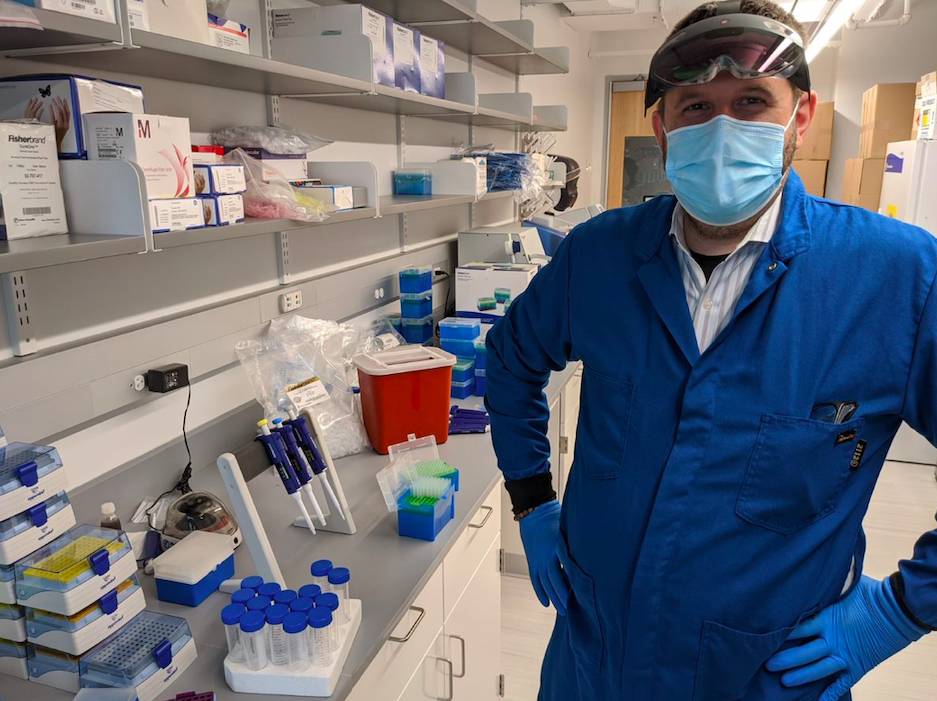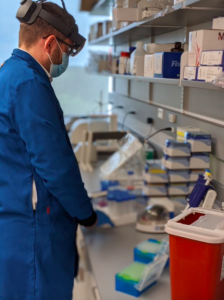|
|
The technology of the future is here—Microsoft’s flagship mixed reality device, HoloLens 2, is in the palms of Northeastern’s hands and Professor Jared Auclair is testing its power in the classroom and beyond.
In 2015, Microsoft announced the advent of their mixed reality invention—an untethered wearable computer with apps and solutions that enhance collaboration. NASA and Lowe’s Home Improvement were some of Microsoft’s initial partners, showing the power of mixed reality in the realm of commercial business and scientific research.
Professor Auclair was well aware of this technology’s potential for innovation at Northeastern. As the Associate Dean of Professional Programs for Bioinformatics, Biotechnology, Chemistry, and Chemical Biology, Auclair is always asking “What kind of cool opportunities are there in the research and education space and how can we leverage that kind of technology at Northeastern?”
Auclair came to Northeastern in 2013 as a postdoctoral researcher with Dr. Jeff Agar, extensively studying mass spectrometry. He then transitioned to the Director of Northeastern’s Biotechnology Professional Science Master’s and Biopharmaceutical Analytical Sciences Certificate Programs out of Northeastern’s campus in Burlington, MA. There, he works in the Biopharmaceutical Analysis Training Laboratory (BATL), where the HoloLens has been an integral part of innovation in biotechnology education.
In a video for Northeastern, Auclair describes incorporating the HoloLens into teaching basic lab techniques, such as pipetting, a necessary skill in the biotech industry. In his course, he demonstrates pipetting to students through the HoloLens’s remote assist and guide programs.
In remote assist, Auclair can wear the mixed reality glasses and host a meeting where the participants can see everything in front of him and annotate the screen to ask questions. “What are these called?” a student might ask and circle a pipette tip box in front of Auclair. On the goggles, Auclair can see what the student has annotated and give an explanation in the meeting, as well as demonstrate how to attach a pipette tip to the end of a pipette.
This incredible technology was useful when virtual learning became common place over the last year. In this case, the HoloLens has been used to guide students through pipetting demonstrations without being in the lab. In a guide program, the HoloLens can walk the student through a series of prompts and indicate how to complete tasks in front of the student, such as using a pipette to dilute a solution accurately.
“I think there is an opportunity to leverage [the HoloLens] in some of the lab classes we do to enhance the experience, not to replace the lab experience,” Auclair said. While working in a lab is always the best learning experience, the HoloLens provides an individualized platform that makes an excellent substitute.
The applications of this tool are endless. On top of being an educational tool, Auclair discussed its usefulness in other areas as well.
“My instrumentation broke. I can call the engineer on my headset, and have them see what I’m seeing, and they can walk me through a repair,” Auclair said. This method would save money and time for labs relying on essential equipment, such as an immense, complex mass spectrometer, as Auclair has experienced in previous research.
Despite the new and exciting nature of the HoloLens, there are challenges and drawbacks. As Auclair mentioned, “the technology was not developed with education in mind, so we would love to have more analytics on the back end so we can learn about the way people are learning through the HoloLens.” Through their agreement, Northeastern and Auclair are working with Microsoft to provide feedback on the educational elements of the tool.
Alternatively, Microsoft has contracted its services to the U. S. Army (a deal that could be worth up to $21.9 billion dollars over the next 10 years), designing a version of the HoloLens specifically for field training. This was met with strong opposition by engineers and employees who worked with the device, claiming that they “have now lost their ability to make decisions about what they work on, instead finding themselves implicated as war profiteers.”
Technology is intensely complicated in nature and with a device as progressive in the mixed reality space as the HoloLens, there will be ways to apply it across many fields, the good, the bad, and the in-between alike.
For Professor Jared Auclair and his students, the HoloLens has made biotechnology training easier both before and after the pandemic, and it will continue to be influential across the university in building virtual education platforms.
“This is a huge benefit of what Northeastern is able to do and bring to their students.” Auclair said. “I think that we are just scratching the surface of what this technology can do educationally for us and research wise. I think it is an exciting opportunity and time to really see what we can do together.”


